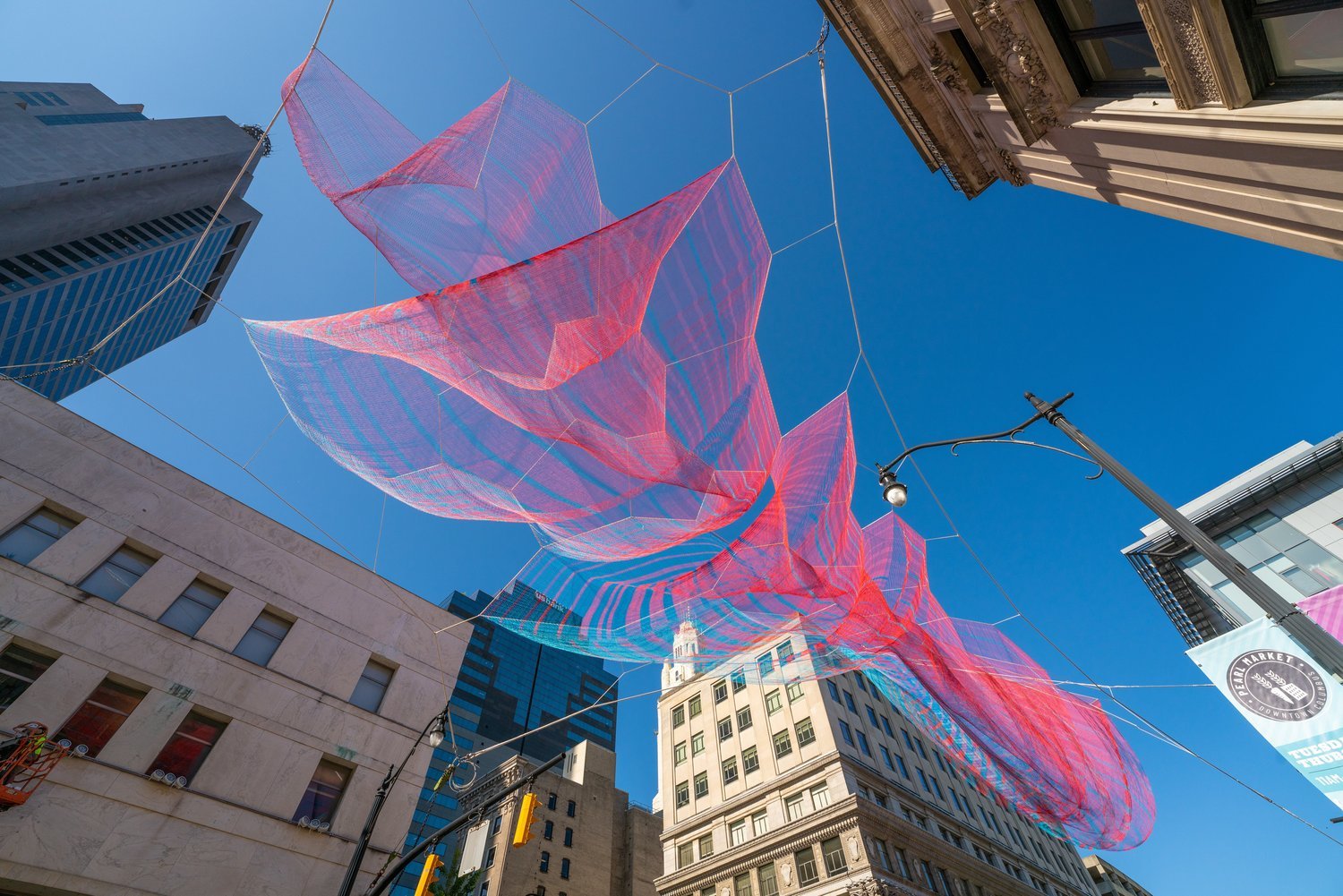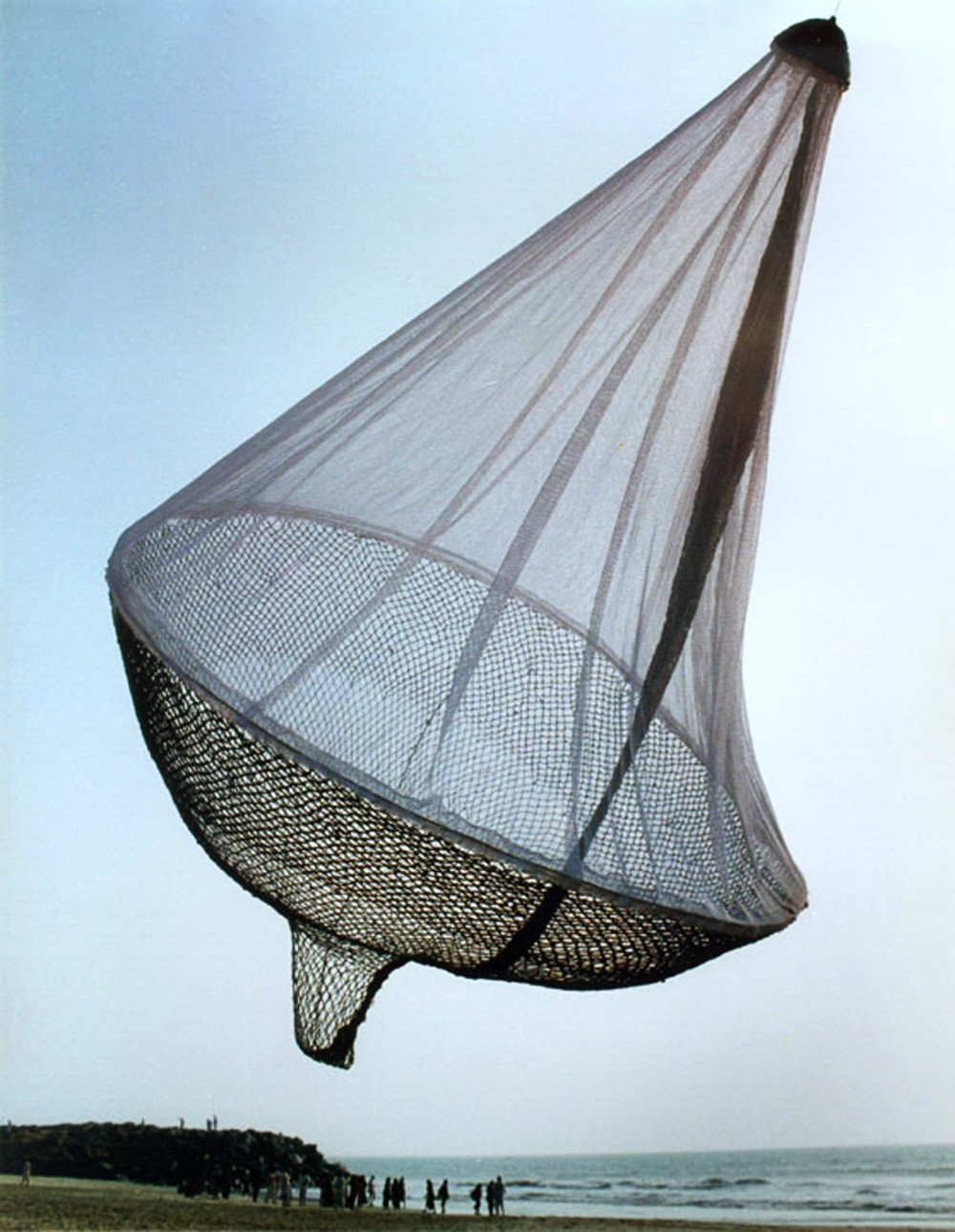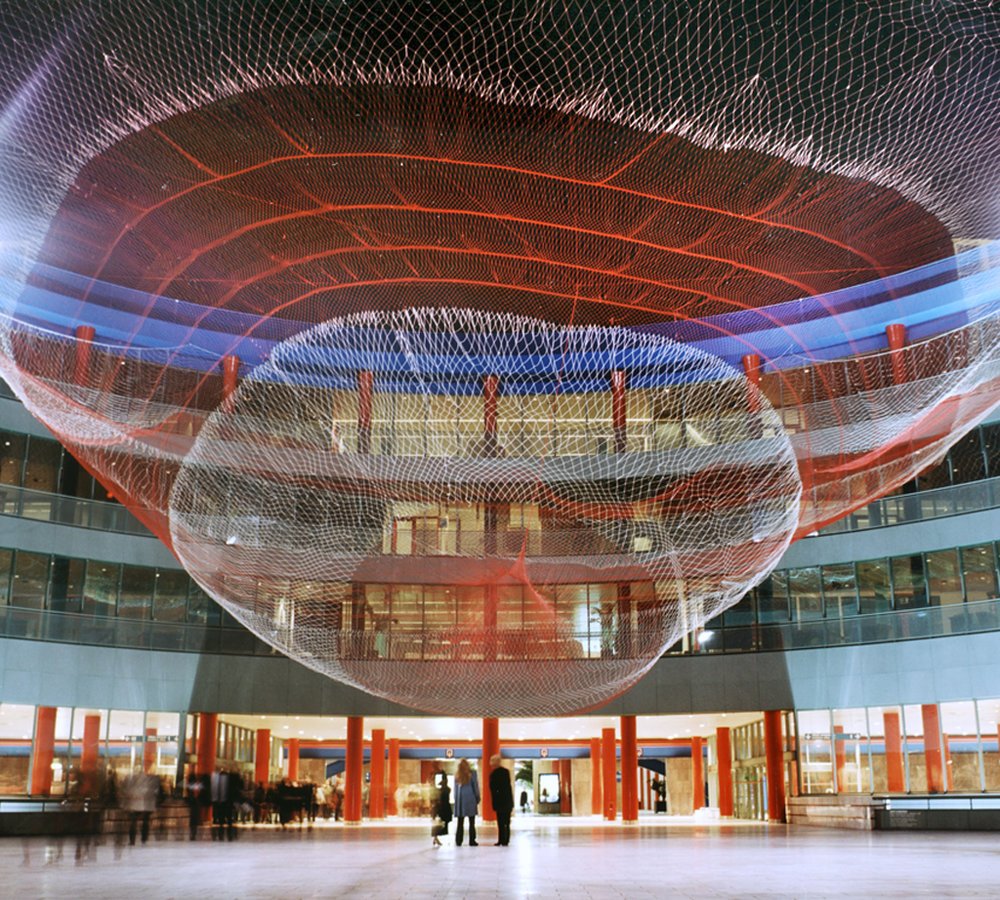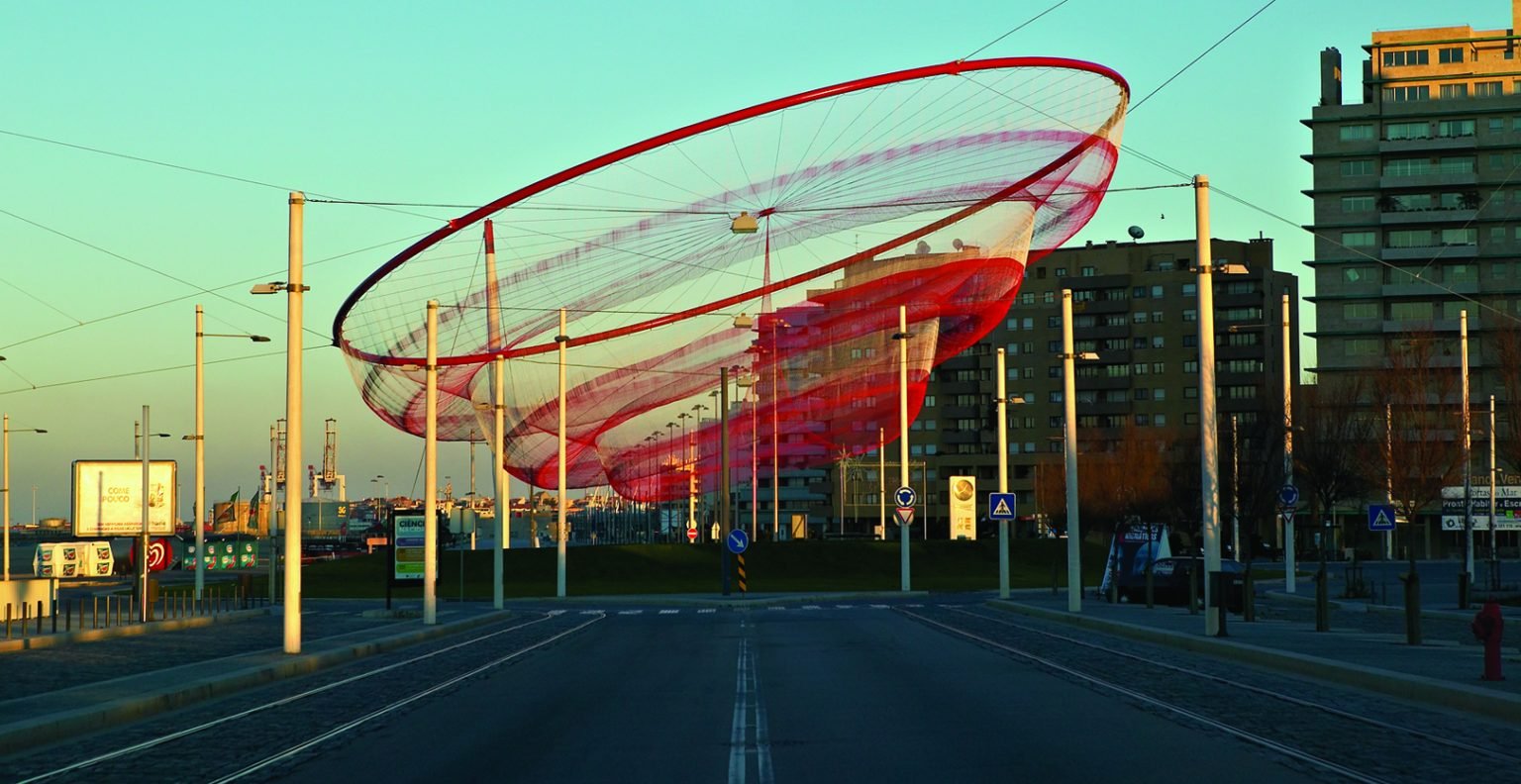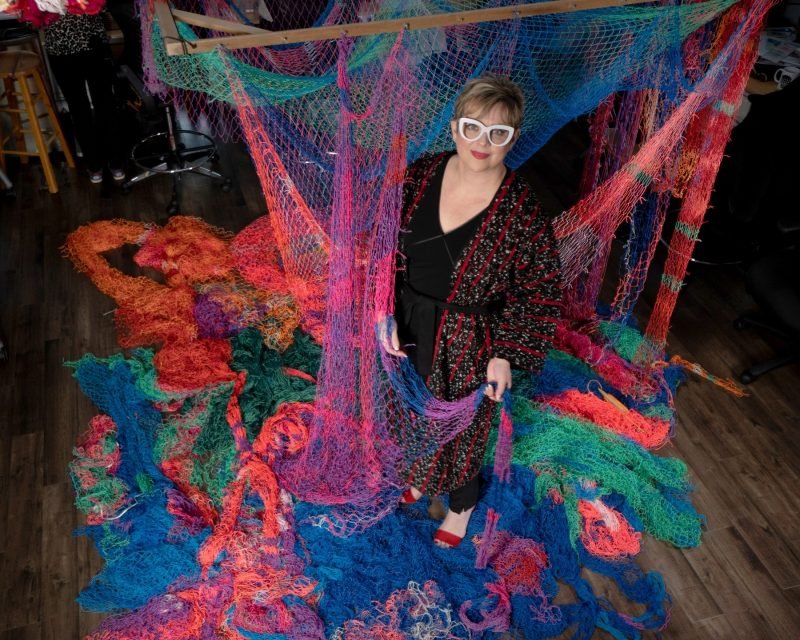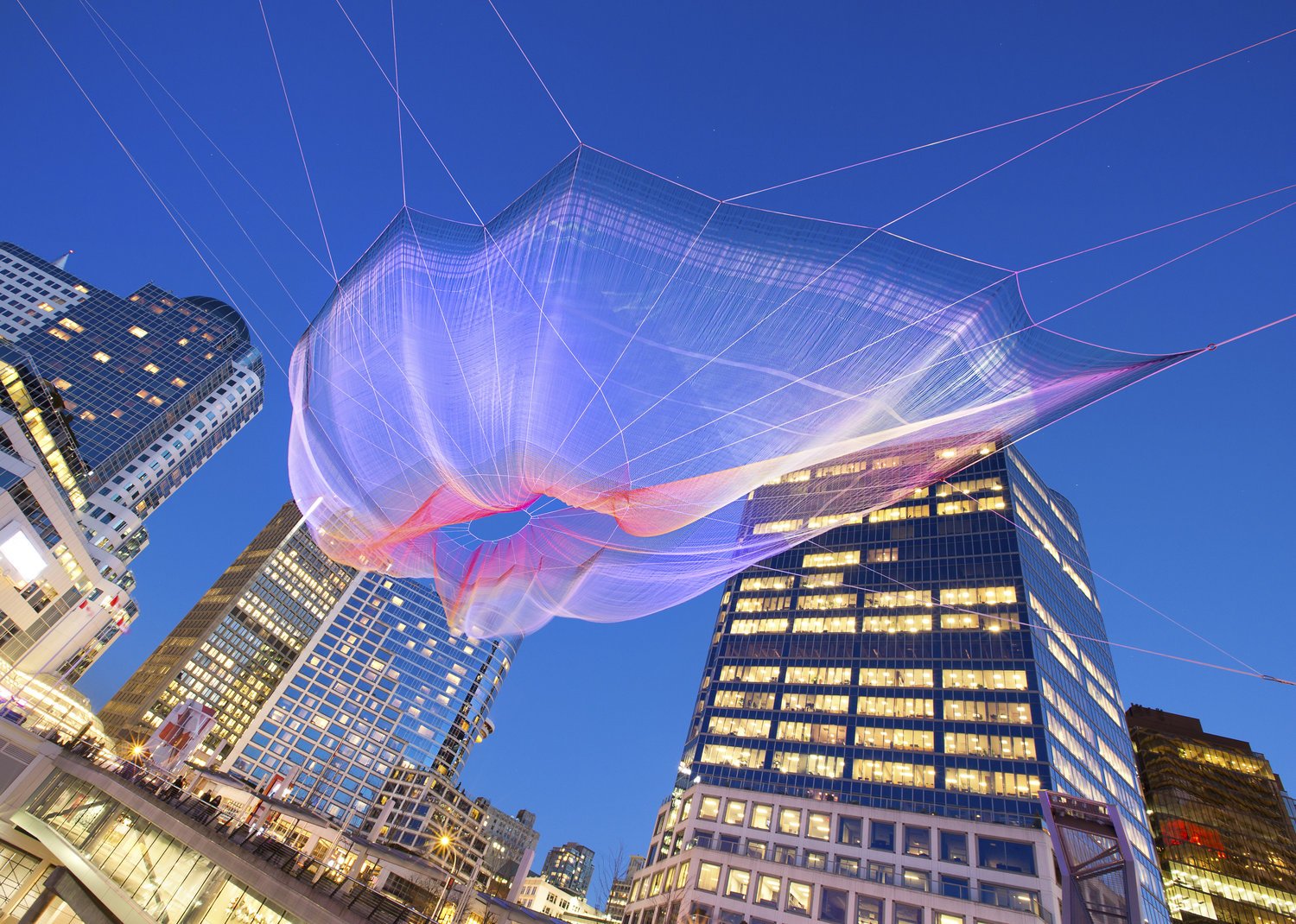Art is in the Air: A Love Affair with Janet Echelman’s Ethereal Sculptures
“Everything you can imagine is real.”
- Pablo Picasso
Oftentimes innovation is born out of serendipity. The fortuitous happenstance led to a seemingly unlikely sculptress: Janet Echelman, who never studied sculpture, architecture or engineering, to creation of awe-inspiring ephemeral installations that revitalise cityscapes and create sense of wonder in public spaces across the world. The truly interdisciplinary work of Janet Echelman encompasses Sculpture, Architecture, Material Science, Urban Design, Structural & Aeronautical Engineering, and Computer Science, defying all conventions of sculpture as we know it, granting a whole new meaning to public art.
Janet Echelman, Current, Columbus, OH, 2023. Photo Courtesy: Bruce Petschek.
It is through synchronous train of unfolding events during Janet Echelman’s stay in India, she rediscovered her artistic voice in a whole new and different dimension. Janet Echelman, 58, Florida born and bred multi-award winner and now a renowned sculptor and a fiber artist, began her artistic journey in painting. Stemming from her innate desire to be an artist despite being rejected from seven art schools, the resilience of her artistic intentions is nothing short of commendable. Janet embarked on a self-contained artistic career in painting for almost ten years. Her inquisitive nature fuelled her interest in art practice though studying Chinese calligraphy, Buddhist Garden design and mixed media, like textile and painting. She sought out any opportunity to master ancient crafts.
In 1997, as a part of prestigious Fulbright Senior Lectureship, Echelman set out on a tour to India to give painting exhibitions on behalf of US Embassy. However, the art supplies shipped over to a small fisherman village of Mahaballipuram never made its destination which left Echelman to seek a creative substitute during her stay. She ventured into sculpture and experienced bronze casting using local materials to soon realise that it was too heavy and expensive. An epiphany moment occurred when one of the many days she strolled alongside the coastline contemplating and watching fisherman stacking their nets on the sand. It was then that the realisation of a new approach to sculpture was born out of her imagination. She interrogated the possibility of a volume through use of light mesh material, the fishermen nets, that were used throughout centuries, as her medium. During the year of her Fulbright stay Echelman collaborated with village fisherman in her new endeavor to later produce a whole series titled ‘Bellbottom’ comprising of five floating sculptures. Amongst others, she produced the self-portrait namely ‘Wide Hips’. The floating hand knotted strings were lifted on the poles and let hover over in the air forming mesmerising patterns ruled by the air currents. The exhibition was funded by the Fulbright Scholarship Board, the US Educational Foundation in India, National Institute of Design of India and the American Consulate of Mumbai/Bombay.
Janet Echelman, Wide Hips, Bell Bottom Series, Mahabalipuram, India, 1997. Photo by Janet Echelman.
Taking keen interest in the craft traditions and continuing to study the artisanry of lace making in Lithuania, Echelman returned to India later to produce the grand artwork in collaboration with the same fishermen by crafting a net out of million and a half-tied knots. The first artwork of such scale ‘Target Swooping Down’, 2001, was assembled in Madrid, Spain for ARCO fair. It marks a pivotal moment in Echelman’s beginnings as well as successive seminal years of important encounters of people who will later aid the process of her artworks with their increasing complexity driven by purpose.
Janet Echelman, Target Swooping Down, Bullseye, Madrid Spain, 2001. Photo by Janet Echelman Studio.
Janet Echelman, Target Swooping Down, Bullseye, view from above, Madrid Spain, 2001. Photo by Janet Echelman Studio.
During the fair Echelman met Manuel Sola-Morales, an urbanist and architect, who introduced new concepts and practices for urban design in Europe. Manuel was redeveloping the waterfront in Porto, Portugal at the time and challenged Echelman to install the permanent sculpture in the city. To blur the boundaries between the engineered and ephemeral, the fiber material had to be durable enough to withstand the adversities of the environment, like air pollution, salt, ultraviolet, hurricanes whist sustaining the softness to be able to interact with natural forces flawlessly. This consideration led Echelman to forge partnerships that expedited the understanding of what was achievable. The result would significantly elevate her work. She would soon partner with aeronautical and acoustical engineers, lacemakers, programmers and even NASA scientists to craft the material and model various elements of its design. Echelman collaborated with Peter Heppel, who designed sails for America’s Cup yacht races, to design the new software that would be able to extrude and model the complex net forms. Developed by W.L. Gore and Associates, almost a ton of architectural fiber netting called Tenara was fabricated, predominantly by hand. Three years and around $1,66 million later, the 50,000 sq ft lace net adorned the intersection at the Praca Cidade San Salvador in the town of Matosinhos outside of Porto overlooking the Atlantic. A conventional intersection, suddenly ’now it had a sense of space’. ‘She Changes’ - Echelman’s first major permanent installation, which embraced ancient craft with precision engineering, makes a lasting spectacle.
Janet Echelman, She Changes, Porto, Portugal, 2005. Photo Courtesy: Enrique Diaz.
Echelman describes her first experience as such: “I walked underneath it first time as I watched winds choreography unfold, I felt sheltered and at the same time connected to limitless sky.”
Colossal in scale, lit up from below the ground level, the netting billowing in the wind is saturated with undulating colors that invigorate the senses and provide a tranquil haven amidst busy roads. This experiential installation was indeed speaking its own language by involving cognitive and visceral feelings which makes it an extraordinary work.
Janet Echelman, She Changes, Porto, Portugal, 2005. Photo Courtesy: Florence Lynch Gallery Photo: Joao Ferrand and David Feldman.
Janet Echelman, She Changes, Porto, Portugal, 2005. Photo Courtesy: David Feldman.
‘She Changes’ was the project that underscored the inception to her ambition: “I want to create these oases of sculpture in spaces of cities around the world.”, Echelman cited. To date, her works are residing across five continents in cities like New York, Sydney, London, Singapore and her permanent works are installed across twelve locations. Echelman’s exhilarating aerial sculptures not only immerse cities into playful color story but are also suspended for contemplation.
Janet has always been drawn to filling the interstitial spaces and assigning them a purpose. With her artworks she revitalises the city line and emphasises spatial relationships through breathing life in the concrete jungle of the hard-edged cityscapes and “weaving her art into the fabric of cities”.
She accentuates the perception of self and space, and how it makes one feel in a given moment. The intentionality of creating such spaces spur a greater potential of unity and shared moments within the public where simultaneously each could experience art out in the open on individual level.
The purpose of the artworks is to activate the contemplation within through the sensory involvement of the floating sculptures that respond to the natural environment.
For the social element to her artwork Echelman draws her inspiration from the way social spaces were created in the past. As an example, the awnings stretched in the Colosseum in Rome to shield its spectators from the blazing sun during the brutal entertainments of antiquity. The so called velarium, a fabric canopy suspended with ropes sloping downwards, served a dual purpose of shading the crowd whilst giving it the communal feel and the sense of togetherness.
“Not everyone feels entitled to walking in an art museum, but everyone feels at home and feels entitled to walk in the street and that’s why for me as an artist, I love to work over the street,” says Echelman. By showcasing her art beyond the walls of any institution, Echelman consciously democratises art.
She continuously pushes the boundaries in her art and takes on complex and challenging projects that usually require incorporating new elements. Each city unfolds as a unique identity and the material used will ultimately reflect that.
Her creative process starts with sketching through to miniature modelling and virtual 3D drape designs. The whole process can take over nine months to realise and it requires a true collective effort from hundreds of contributors like engineers, craftsmen and designers. “It starts with the raw fiber, we braid every single twine and rope ourselves from these highly engineered fibers for the structural role in the sculpture.” The material is fifteen times stronger than steel, the fiber is made from ultra-high-molecular weight polyethylene.
Janet Echelman in her studio, 2014. Photo Courtesy: Bruce Petscheck, The Washington Post.
The sculpture, Skies Painted with Unnumbered Sparks, 2014, Vancouver, Canada - an extraordinary encounter on the street that breaks you out from the mundane routines and encourages to look above to shift your perspective for a moment.
Monumental in scale and next generation interactive aerial sculpture was installed between the 24-story Fairmont Waterfront skyscraper and the Vancouver Convention Center stretched across at 745 ft length over 175 ft high in the centre of the downtown. The project was commissioned by Chris Anderson, the curator of Ted Talks, in celebration of the 30th Anniversary of the TED Conference. Echelman worked alongside Aaron Koblin, the Creative Director of Google’s Data Arts Team, who created an interactive lighting system for the sculpture. Passersby turned from mere spectators into co-creators and were able to collaborate with each other. Anyone could connect to the server simultaneously with their smartphones and draw or paint with light adding to the flowing visual layers of the net sculpture above.
Janet Echelman, Skies Painted with Unnumbered Sparks, Vancouver, Canada, 2014. Photo Courtesy: TEDphoto, Bret Hartman.
It is believed to be the largest roped structure in the world. Almost one million feet of braided fibre was used, appearing lighter than the air, yet stronger than 95mph winds.
Creating one of the grandest and most challenging projects amidst active city for TED Conference, was especially symbolic for Janet Echelman, who is well known for her TED Talk on “Taking imagination seriously”, that was translated into 45 languages. The onlookers were captivated by the grandeur of the artwork calling it ‘sublime and magical.’
Janet Echelman, Skies Painted with Unnumbered Sparks, Vancouver, Canada, 2014. Photo Courtesy: Ema Peter.
Earthtime 1.26, Milan, 2022
In 2022, the giant billowing multi-coloured net sculpture, the Earthtime 1.26, was suspended over Milan’s Biblioteca deli Alberi (BAM) park transforming this urban landmark. The title refers to 1.26 microseconds by which the earth’s day was shortened after a ripple effect of the earthquake and tsunami in Chile in 2010 across the Pacific and globe. Based on the scientific data set of seismic and geological activity, the structure was digitally modelled and then translated into the voluptuous fluid forms of intertwined fibres moving graciously in the wind, saturated with color. It was a collaborative effort of aeronautical, structural and software engineers, computer scientists, lighting designers, landscape architects and fabrication team.
Janet Echelman, Earthtime 1.26, Milan, Italy, 2022. Photo Courtesy: Janet Echelman.
The works in the Earthtime sculpture series symbolise the interconnectedness between nature and humans and their resilience in uncontrollable circumstances. “My artwork reflects an interconnectedness of opposites - flexibility with strength, earth with sky, things we can control with the forces beyond us,” shares Echelman. The Earthtime 1.26 was installed in 16 cities on 5 continents.
Earthtime 1.26, Riyadh Art, 2023
Echelman’s recent work in the series Earthtime 1.26 premiered in Riyadh, Saudi Arabia, in December 2023. As a part of Riyadh Art, national public initiative, for light festival, Noor Riyadh the sculpture was suspended amid Wadi Namar site. The sculpture was brought to life through collaboration with SOM (Skidmore, Owings & Merrill), a collective of architects, designers, engineers and planners. The desert setting was tranquil and had a meditative aura. By placing majlis sofas under the artwork the space transformed into a contemplative area where the experience of the vast open sky and the Arabian moon through wondrous floating sculpture made the time memorable.
Janet Echelman, Earthtime 1.26, Wadi Namar, Saudi Arabia, 2023. Photo Courtesy: Janet Echelman.
Echelman holds numerous prestigious awards in the past like Smithsonian American Ingenuity Award in Visual Arts, Architectural Digest Innovator for ‘changing the very essence of urban spaces. In 2023 she received two international awards: the Boston Society of Architect’s Harleston Parker Medal and the Isler Prize of the International Association for Shell and Spatial Structures (IASS). Echelman is the first artist who received the Harleston Parker award in its 99-year history.
Her works range from interior sculptures hung from the ceilings transformed in protected light to outdoor voluptuous fibre forms looming over the cities defying gravity and moving graciously with natural forces. All her sculptures are equally captivating and hypnotising akin magical Aurora borealis undulating twinkling accompanied by Schubert's Symphony No. 5.
“I searched for beauty in traditional craft forms and now I combine them with high tech materials and engineering to create voluptuous billowing forms at the scale of buildings. My artistic horizons continue to grow.” This is true as Janet Echelman’s art does not seize to elevate senses anew with every artwork; her ephemeral and dynamic pieces that breathe life are truly timeless.
Footnotes:
[3] https://www.ted.com/speakers/janet_echelman
[4] https://www.architecturaldigest.com/story/artist-janet-echelman-sculptures-article
[5] https://www.smithsonianmag.com/innovation/when-dazzling-art-transforms-cityscape-180953043/
[8] https://sculpturemagazine.art/janet-echelmans-she-changes/
[9] https://www.througheternity.com/en/blog/history/colosseum-rome-velarium-roof.html
Anastassia Taylor
En Plein Air Co-Editor, MADE IN BED


